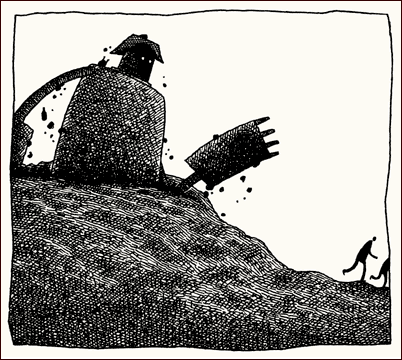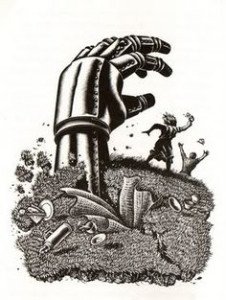Five years after Sylvia Plath’s suicide, Hughes wrote Iron Man as entertainment to help their children Frieda and Nicholas deal with their mother’s death.
The story is a fantasy about a colossal Iron Man (from somewhere unknown in the universe) with an appetite for eating metals—motorcars, power lines, and rusty nails. He’s stopped when Hogarth, a boy in his early teens, figures out that the best thing is to dig a huge pit and bury him under a mound of earth when Iron Man falls into it.
For some years, people forget that the Mound is a burial plot, and when a family unknowingly decides to picnic there, they are surprised because they think they are picnicking on a grassy mound. So, the family spreads a cloth and unpacks “a roasted chicken, a bottle of milk, a bowl of tomatoes, a bagful of boil eggs, a dish of butter and a loaf of bread, with cheese and salt and cups.” Then, the earth rumbles and quakes, a crack opens, and the colossal Iron Man slowly digs himself out. The family runs in consternation. The picnic is wrecked. But Iron Man is eventually placated, and the story ends upbeat.
Unfortunately, it was easier for Hughes to smooth over the family troubles in fiction, which they could not do in life.
Featured Image: Tom Gauld. Iron Man emerges from the Mound. From Ted Hughes. The Iron Man: A Story in Five Nights (London: Faber and Faber, 2005)
See Ted Hughes. The Iron Man: A Story in Five Nights. Illustrated by George Adamson. London: Faber and Faber, 1968; Tom Gauld. Iron Man emerges from the Mound. From Ted Hughes. The Iron Man: A Story in Five Nights (London: Faber and Faber, 2005) * For the 1968 U.S. publication, the title was Iron Giant.


